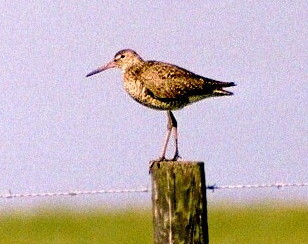
 |
|
||
| Great Lakes-Big Rivers, Region 3 | Migratory Birds | ||
(to identify birds by their families, click on the bird graphic above)
|
Surveys
|
The U.S. Fish and Wildlife Service
(Service) is the Federal agency responsible for the management of migratory
birds as they spend time in habitats of the United States. Many of these
birds, however spend only part of their lives within the United States. Countries
such as Canada and Mexico are also home to these birds during certain times
of the year. The United States works closely with these countries to
ensure quality wintering and summering habitats. Over 800 species of birds have been identified within the United States. This number includes those birds which nest, spend the winter and migrate through the U.S., as well as those birds that have been introduced into the U.S. from other countries and birds that get lost and show up here accidentally. Approximately 500 species occur in the U.S. Fish and Wildlife Service eight state region which includes: Illinois Indiana Iowa Michigan Missouri Minnesota Ohio Wisconsin Waterfowl, rails, woodcock, snipe, mourning doves and cranes are migratory game birds. All the others, with a few exceptions, are non-game birds. Turkey, quail, grouse and prairie chickens are non-migratory game birds and fall under the jurisdiction of the state governments. The U.S. Fish and Wildlife Service works closely with state fish and game and natural resource departments to ensure the well-being of this region's birds. |
Among
the 500 species in this region, 72 species are
rare or of special concern, because their numbers
are declining. A document outlining this list of these species, developed by the
Service, may be viewed by clicking on the
Kirtland's Warbler at the below:
 fws photo
fws photo
The goals of the U.S. Fish and Wildlife Service's migratory bird management program are to maintain and enhance migratory bird populations and habitats, and to provide people with opportunities to learn about and enjoy these species. The Service enforces the Migratory Bird Treaty Act (protecting bird populations from over exploitation), coordinates and conducts bird surveys, bands birds, supports research, sets hunting regulations, issues permits for the take of certain birds and protects and restores migratory bird habitats.
Migratory Birds are wide-ranging and use a diversity of habitats, therefore, the U.S. Fish and Wildlife Service must collaborate with other agencies and organizations to manage these species. Below are links to six cooperative initiatives you can learn more about.
 |
 FWS photo Whooping Crane Eastern Partnership |
 |
 FWS photo Partners in Flight |
 FWS photo |
Here are other U.S. Fish and Wildlife Service offices with significant bird information:
U.S. Fish and Wildlife Service National Migratory Bird Web Page
Division of Bird
Habitat Conservation
Duck
Stamp Program
Endangered
Species
National Wildlife Refuge System
The Sister
Shorebird program and the
Junior Duck Stamp program are programs for
teachers and school children to get involved learning about birds.
To learn more about migratory birds
in the Great Lakes/Big Rivers
Region,
contact the Migratory Bird Office
at 612-713-5458, or
the North American Waterfowl
Management Plan Joint Venture Office
at 612-713-5433 or 612-713-5364.
This web site was designed by Deanne
Endrizzi: deanne_endrizzi@fws.gov
All photos, unless otherwise noted, by Deanne Endrizzi